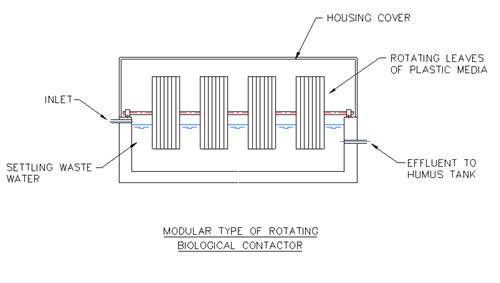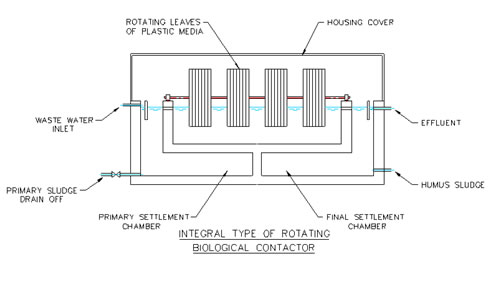Rotating biological contactors
Rotating biological contactor (RBC)…
The rotating biological contactor is a secondary treatment system. It provides aerobic treatment of a fixed-film of biomass.
RBC Operation
The rotating biological contactor consists of a series of plastic discs mounted on a shaft. The discs are a medium on which biomass can grow. The shaft is slowly rotated over a tank into which settled wastewater is introduced. The plastic discs are submerged to about 40% of their depth within a tank and the biomass is alternately in contact with the wastewater and oxygen in the air.
The organic pollutants in the wastewater are absorbed into the biomass during the submerged phase and oxygen is absorbed primarily in the aerial phase. The treatment of the wastewater takes place through the oxidation of the organic matter and biological flocculation. The treated effluent contains some of the biomass which sloughs off the plastic medium. This passes through to a humus tank to produce a clarified effluent.

RBC Variants
Variations of this theme are available. Some RBCs have two compartments with a rotating shaft in each. The compartments are biozones. The first shaft takes in effluent through circumferential openings in the disc, the effluent trickling to openings near the hub of the shaft and passing in to the second chamber. This system serves to regulate flows, balancing peaks and troughs of the influent and can be particularly effective when wide variations in flows are anticipated.
Most of the treatment of the effluent takes place in the larger second chamber. At times of low flow some of the treated effluent can be returned from the second chamber to the first to maintain effective operation of the plant. This reduces the risk of anaerobic conditions being established which would impair the efficiency of the plant.

Sewerage Services
Sewerage Systems
Package Sewage and Wastewater Treatment Plant
Biological Filtration Secondary Treatment System
Rotating Biological Contactors
Biological Aerated Filter
Submerged Aerated Filters
The Treatment of Sewage using Activated Sludge
The Secondary Treatment of Sewage using a Sequencing Batch Reactor
Water Services >>

